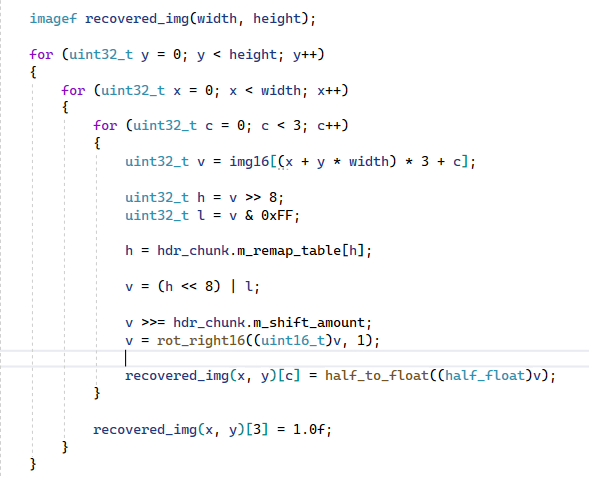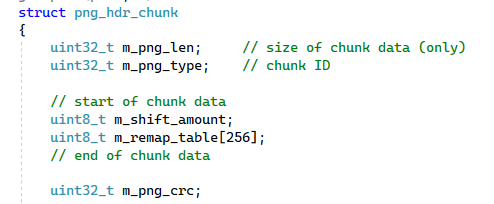- From: Richard Geldreich <rich@binomial.info>
- Date: Mon, 13 Nov 2023 10:25:44 -0500
- To: Leonard Rosenthol <lrosenth@adobe.com>
- Cc: "public-png@w3.org" <public-png@w3.org>
- Message-ID: <CAMJqMUS3acxvkz5nmNXFYY-BdT_w0cU9XXZFuC1vpn0QeQiuMQ@mail.gmail.com>
It's interesting that the sBIT chunk describes a process quite similar to what we're doing to the integer bits of half-floats, to get the high bytes in a form that resembles sRGB pixels. The "sample values should be scaled to the full range of possible values" - which is exactly what the proposed half float encoding does to the high bytes after the sign bit is rotated left into the LSB. Half-floats are a IEEE spec, and very popular on GPU's, so I don't see why PNG cannot define a chunk and a spec for how the standardized half floats are mapped. On Mon, Nov 13, 2023 at 10:18 AM Richard Geldreich <rich@binomial.info> wrote: > >If you add the `sRGB` tag, so that it is clearly declared that such is > the case, then at least you have specified the color appropriately. > > Not everyone specifies the color appropriately. In practice, PNG is not > just a format used for *only* viewing files on a monitor. It's also an > interchange format used between programs. In common cases the colorspace is > implied or communicated external to .PNG. > > Yet users are still able to preview and view their files using common > OS's, browsers. It's not ideal but the software/OS/tool ecosystem works > this way in practice. > > On Mon, Nov 13, 2023 at 10:13 AM Leonard Rosenthol <lrosenth@adobe.com> > wrote: > >> If you add the `sRGB` tag, so that it is clearly declared that such is >> the case, then at least you have specified the color appropriately. >> >> >> >> And if someone wants to treat the values as something else – such as HDR >> data – they can do so, out of scope to the spec…which is also fine(-ish). >> >> >> >> Leonard >> >> >> >> *From: *Richard Geldreich <rich@binomial.info> >> *Date: *Monday, November 13, 2023 at 10:10 AM >> *To: *Leonard Rosenthol <lrosenth@adobe.com> >> *Cc: *public-png@w3.org <public-png@w3.org> >> *Subject: *Re: backwards compatible half-float PNG test app >> source+examples >> >> *EXTERNAL: Use caution when clicking on links or opening attachments.* >> >> >> >> > BUT if they are “backwards compatible” (as you discuss), then at least >> for that use case, they still need to be relevant to a color space. And >> what is that? >> >> >> >> If we take an .EXR image downloaded from the web without >> "chromaticities", "whiteLuminance", or "adoptedNeutral" fields (which are >> defined as strictly optional in the spec itself, and aren't always used) - >> what colorspace is the output half-float PNG? >> >> >> >> The high bytes in the half float PNG (which is what Windows and other >> views will preview and view 16-bit PNG's as) in the lossless encoding I've >> proposed will be in sRGB. >> >> >> >> On Mon, Nov 13, 2023 at 10:00 AM Leonard Rosenthol <lrosenth@adobe.com> >> wrote: >> >> But any pixel value is only useful when considered in a given color space >> – unless, as Chris noted in his message, that you don’t consider these >> values for display and only for “data storage”. And if that is the case, >> then PNG isn’t the right place for them. BUT if they are “backwards >> compatible” (as you discuss), then at least for that use case, they still >> need to be relevant to a color space. And what is that? >> >> >> >> Yes, I agree that EXR is a complex format – been working with that team >> on adding C2PA support, so I get it. >> >> >> >> But just because you have a hammer, doesn’t make everything a nail… >> >> >> >> Leonard >> >> >> >> *From: *Richard Geldreich <rich@binomial.info> >> *Date: *Monday, November 13, 2023 at 9:52 AM >> *To: *Leonard Rosenthol <lrosenth@adobe.com> >> *Cc: *public-png@w3.org <public-png@w3.org> >> *Subject: *Re: backwards compatible half-float PNG test app >> source+examples >> >> *EXTERNAL: Use caution when clicking on links or opening attachments.* >> >> >> >> >First off, HDR doesn’t mean anything without (at least) a CICP table. >> So are you adding a standard cICP tag as well to your images? >> >> The half float encoding != colorspace. Ward: "Because it [half floats] >> can represent negative primary values along with positive ones, the OpenEXR >> format covers the entire visible gamut and a range of about 10.7 orders of >> magnitude with a relative precision of 0.1%." It can handle any colorspace. >> Also according to Ward, many .EXR images don't actually encode the >> *optional* " chromaticities", "whiteLuminance", and "adoptedNeutral" >> .EXR fields in the file, yet somehow we've survived. >> >> >Second, what is the benefit to your published, but proprietary solution >> over an open specification such as OpenEXR? >> >> The Windows OS will not preview or view .EXR files, but it will preview >> and view half-float encoded PNG files if saved correctly in a lossless >> manner which we've already solved. >> >> >> >> "TinyEXR" is 10,000 lines of code, not counting the miniz library for >> Deflate support (which I wrote BTW). It can only load ~70% of the EXR's in >> the wild, so as a reliable interchange format it's terrible.OpenEXR itself >> is too much code and too bloated (dozens of source files). >> >> >> >> The half-float encoding is an industry standard (IEEE 754-2008), and is >> widely supported in GPU hardware and in GPU shader languages: >> https://en.wikipedia.org/wiki/Half-precision_floating-point_format >> >> >> >> >> >> On Mon, Nov 13, 2023 at 9:33 AM Leonard Rosenthol <lrosenth@adobe.com> >> wrote: >> >> Richard – I don’t understand. >> >> >> >> First off, HDR doesn’t mean anything without (at least) a CICP table. So >> are you adding a standard cICP tag as well to your images? If you are >> doing that, then at least you’re creating something that can be used in >> other workflows. This is especially important as you think about how these >> images will be composited with other HDR content, but in other formats…for >> example, consider a web page with both one of your PNGs and a JPEG (using >> the upcoming standard)… >> >> >> >> Second, what is the benefit to your published, but proprietary solution >> over an open specification such as OpenEXR? Just that it happens to work >> in PNG instead of some other format? From a wider industry perspective, I >> don’t see the benefit and instead lots of downsides to users worldwide who >> will now be confused why their images don’t work as expected. >> >> >> >> I’m certainly in favor of moving HDR forward – but IMO, we need to do it >> consistently as an industry and not a series of “one offs”…. >> >> >> >> Leonard >> >> >> >> *From: *Richard Geldreich <rich@binomial.info> >> *Date: *Monday, November 13, 2023 at 9:10 AM >> *To: *Leonard Rosenthol <lrosenth@adobe.com> >> *Cc: *public-png@w3.org <public-png@w3.org> >> *Subject: *Re: backwards compatible half-float PNG test app >> source+examples >> >> *EXTERNAL: Use caution when clicking on links or opening attachments.* >> >> >> >> > Before introducing another PNG-specific approach, we should see where >> the industry is going and see if we can align with them first (which I >> believe we can/should). >> >> >> >> We need 16-bit/component half float encoding support (not "color" - >> that's a different problem) right now for our HDR codec work, so I'm going >> to open source this couple hundred line HDR PNG solution with a small easy >> to understand readme doc this week, using a ZLIB+Public Domain license. >> I'll then work with PNG library authors to get it supported into their libs >> and modify existing open source viewers to load HDR PNG's. >> >> >> >> We're already using half-float HDR PNG images for testing and development >> in our codec work here. It's backwards compatible with all existing readers >> and OS's, unlike .EXR, so it's a no brainer for us. >> >> >> >> Best regards, >> >> -Rich >> >> >> >> On Mon, Nov 13, 2023 at 8:35 AM Leonard Rosenthol <lrosenth@adobe.com> >> wrote: >> >> Richard – very interesting work, thanks for sharing! >> >> >> >> However, it isn’t in line with where the rest of the industry is going >> with respect to HDR imaging. Currently ISO TC 42, TC 171, TC 130, JTC 1/SC >> 29 and the ICC are jointly working on a set of proposals for how to encode >> various aspects of HDR data – including gain maps – into common formats and >> technologies (including PNG). The groups will be meeting in Tokyo in >> February for a full day working session to continue to move this work >> forward. I believe that Chris Lilley will be there (perhaps remotely?) as >> well as myself. >> >> >> >> We already have some complex logic in PNG with respect to color and HDR >> (cICP vs. iCCP vs. gAMA vs sRGB vs ….). Before introducing another >> PNG-specific approach, we should see where the industry is going and see if >> we can align with them first (which I believe we can/should). >> >> >> >> Leonard >> >> >> >> *From: *Richard Geldreich <rich@binomial.info> >> *Date: *Friday, November 10, 2023 at 11:05 PM >> *To: *public-png@w3.org <public-png@w3.org> >> *Subject: *Re: backwards compatible half-float PNG test app >> source+examples >> >> *EXTERNAL: Use caution when clicking on links or opening attachments.* >> >> >> >> Here's how the half float pixel values are losslessly recovered from >> 16-bit/component HDR PNG images in the "hdrpng" example code. This is the >> entire decoding procedure. >> >> >> >> This code extracts the low and high bytes from the stored PNG's 16-bpp >> pixels, remaps the high byte through the lookup table read from the "hdRa" >> ancillary chunk (below), shifts right the 16-bit value from [0,15] bits >> (this is typically 0, but for darker images it may be a small # of bits), >> and then rotates the sign bit back into the MSB from the LSB of the 16-bit >> value. This standard half float value can then be processed in an HDR >> pipeline. >> >> >> >> The lossless encoder that takes half-floats and outputs 16-bit PNG values >> is more complex, but not by much. It has to determine the shift amount by >> examining all the half floats in the image and a high byte histogram, and >> then compute a 256 entry lookup table using some sort of tone mapping >> algorithm. The table must be computed in a way that results in no loss. >> >> >> >> >> >> On Fri, Nov 10, 2023 at 4:48 AM Richard Geldreich <rich@binomial.info> >> wrote: >> >> If you want to see these example HDR .PNG's, unpacked to HDR .EXR files, >> using an in-browser HDR viewer, I've unpacked them (using the example >> hdrpng tool) to github here: >> >> https://github.com/richgel999/png16/tree/main/bin/unpacked >> >> >> >> The EXR viewer app (it's pretty good - I use it for testing on SDR >> monitors): >> >> https://viewer.openhdr.org/ >> >> >> >> >> >> On Fri, Nov 10, 2023 at 4:34 AM Richard Geldreich <rich@binomial.info> >> wrote: >> >> I've found a lossless and trivally invertible transform that takes >> half-float HDR values (typically read from .HDR or .EXR images) and packs >> them to 16-bit unsigned pixels that are completely compatible with existing >> non-HDR aware PNG software. It uses a simple invertible and lossless global >> tone mapping operator that operates directly on the half-float values. Old >> readers view and see these PNG's as 16-bit PNG's (so usually 48bpp per >> pixel for RGB). >> >> >> >> The high bytes are tone mapped so the 16bpp images appear passable to >> existing readers. New readers can parse a small ~257 byte ancillary chunk >> which contains a byte remapping table used to remap the high bytes of the >> 16-bit components in the PNG image back to half-floats. (It's a little bit >> more complex than this to deal with signed floats and very low values, but >> that's the gist of it.) It's lossless for all valid half-float values >> (normals, denormals, signed). I filter out any NaN's/Inf"s in this test. >> >> >> >> You can see a bunch of example 48-bpp PNG's packed from .EXR images in >> this way here: >> >> https://github.com/richgel999/png16/tree/main/bin >> >> >> >> The C++ source to the example "hdrpng" tool is here. The example app >> excluding image reading/writing is only ~450 lines of code. (It currently >> compiles with VS 2022 under Windows - I'll add a Linux cmake file next.) >> >> https://github.com/richgel999/png16/ >> >> >> >> It uses the popular open source lodepng library, unmodified, to write and >> read 16-bit PNG files and manipulate the ancillary "hdRa" chunk. >> hdrpng supports packing and tone mapping .EXR images to .PNG, unpacking HDR >> .PNG to .EXR, and an .EXR file comparison mode to verify that the half >> float values can be 100% recovered from the PNG file with no loss. The tone >> mapping in this example is automatic. >> >> >> >> I've tested the resulting 48bpp PNG files with pngcheck, Windows >> Explorer, Chrome, Paint Shop Pro, several tools, and the Windows Photo >> viewer app. So far, so good - they all look fine. >> >> >> >> Here are a couple example 48bpp PNG files. (Not sure what gmail will do >> to them, but this is what they look like.) These are how existing PNG >> readers view these HDR files. The half-float data is 100% preserved in >> these .PNG files, so HDR capable viewers are able to retrieve the original >> half-float pixels and do their own tone mapping or HDR processing. >> >> >> >> >> >> These PNG's validate successfully using pngcheck, because they are >> completely standard PNG files that any reader can load: >> >> >> >>
Attachments
- image/png attachment: Kapaa.png

- image/png attachment: memorial.png

- image/png attachment: image.png

- image/png attachment: 04-image.png

- image/png attachment: 05-image.png

Received on Monday, 13 November 2023 15:26:22 UTC